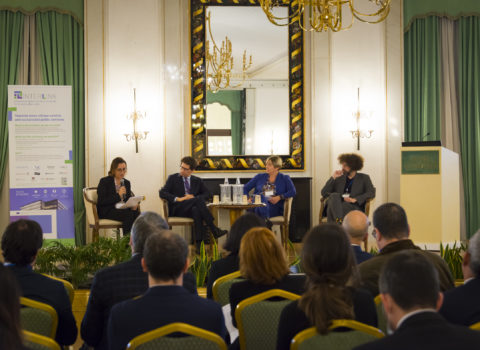
New digital frontiers: the Interlink collaborative environment for increasingly citizen-centered public services
Public and private entities, organizations and citizens from six European countries participated in the project coordinated by Fondazione Bruno Kessler
After an intensive research and later testing phase, which lasted about 36 months, the Horizon 2020 INTERLINK project, coordinated by Trento-based Fondazione Bruno Kessler, comes to an end having achieved its goal of creating a collaborative environment for the co-production of citizen-centered public services.
More than 20 Public Administrations and 420 users were involved, which contributed to the definition of as many as 77 digital facilitators (Interlinkers) and 6 process schemes.
“INTERLINK has shown how effective collaborative innovation can be,” Project Coordinator Matteo Gerosa, from Fondazione Bruno Kessler, stressed. “We achieved transformative results that could trigger long-term changes. These include a governance model that stems from the interdisciplinary work of public, private actors, organizations and citizens. We tested this model in three pilot cases (Italy, Spain, Latvia), rebuilding trust, transparency and a deep sense of accountability of citizens towards administrations. In conclusion, INTERLINK can be a point of reference for all those PAs that are working for the democratization of public services, including digital ones.”
The collaborative environment
It took more than 190 meetings (in-person and online) between the 10 INTERLINK partners to develop the user-friendly collaborative environment. This was a complex task that required the definition of multiple Interlinkers to enable users to collaborate, interact, motivate, mobilize resources, and make decisions. In addition, the collaborative environment accommodated different governance models and – to meet the requirements of each, to ensure quality and reliability as well as compliance with EU regulations -many adaptations were necessary.
Interlinkers
Interlinkers are digitized tools with building block logics, “pieces of software” or knowledge, that are interoperable, reusable, compliant with EU regulations, and standardized. The collaborative environment contains the catalog of 77 Interlinkers grouped into theme clusters that are flexible and able to add new resources to meet specific co-production needs.
Pilot cases
The project involved partners from the world of research, business, and public bodies and developed three pilot cases to test the collaborative environment in Italy, Latvia, and Spain.
Italy – The Ministry of Economy and Finance (MEF), which has extensive experience in bottom-up collaborative approaches, tested the collaborative environment by developing a prototype of a Participatory Strategic Planning Module that enables public bodies and their staff to actively participate in the definition of the MEF Strategic Plan.
Latvia – The Ministry of Environmental Protection and Regional Development of the Republic of Latvia wanted to improve the services provided by the Government Portal (https://latvija.lv/EN). In order to make them more accessible, service descriptions were improved through an elaborate process within the collaborative environment, which involved various actors, such as digital agents, social workers and PA representatives.
Spain – The goals of the Municipality of Zaragoza were to integrate and enhance co-creation and co-delivery of services, to expand the community built around the urban innovation hub – the Etopia Center for Arts and Technology. Through the Collaborative Environment, the municipality has collected high-quality feedback, simplified the way stakeholders access the center to look up tangible and intangible resources (through more transparent reservations, improving resource management), and optimized its service catalog. It also initiated the “cultural” shift from citizens to co-producers and co-providers of services, in line with an open source approach, and tested innovative methods to improve engagement and participation through tokens and gamification.
Building communities with rewarding tools and co-business models
Information and communication technologies (ICT) served to rebuild citizens’ trust in PA by making it easy for them to engage within the collaborative environment. Motivating stakeholders and keeping them operational during the design, development, and production phases proved critical. INTERLINK has contributed to reduce fragmentation, facilitate collaboration, and ensure continuity through rewarding tools, such as, for example, a co-business model to reward citizens for engaging in co-production processes. Such a model uses tokens to reward the most active users, allows for “benefit exchange” to maximize earnings, provides benefits when their tasks are replicated by others.
INTERLINK (Innovating goverNment and ciTizen co-dEliveRy for the digitaL sINgle marKet) is a 36-month project that started in January 2021 and ended in December 2023. It was selected from the proposals submitted for H2020-SC6-GOVERNANCE-2018-2019-2020 under the Governance for the Future topic.
The coordinator is Fondazione Bruno Kessler. The other partners are:
- University of Deusto
- Tree Technology (TREE)
- Radboud University
- Cloud’N’Sci Ltd
- UCLouvain
- Deda Next
- ministero dell’economia e delle finanze-MEF
- Ministry of Environmental Protection and Regional Development of the Republic of Latvia
- The Municipality of Zaragoza and the Etopia Center for Arts and Technology
Media resources: https://interlink-project.eu/media-kit/


